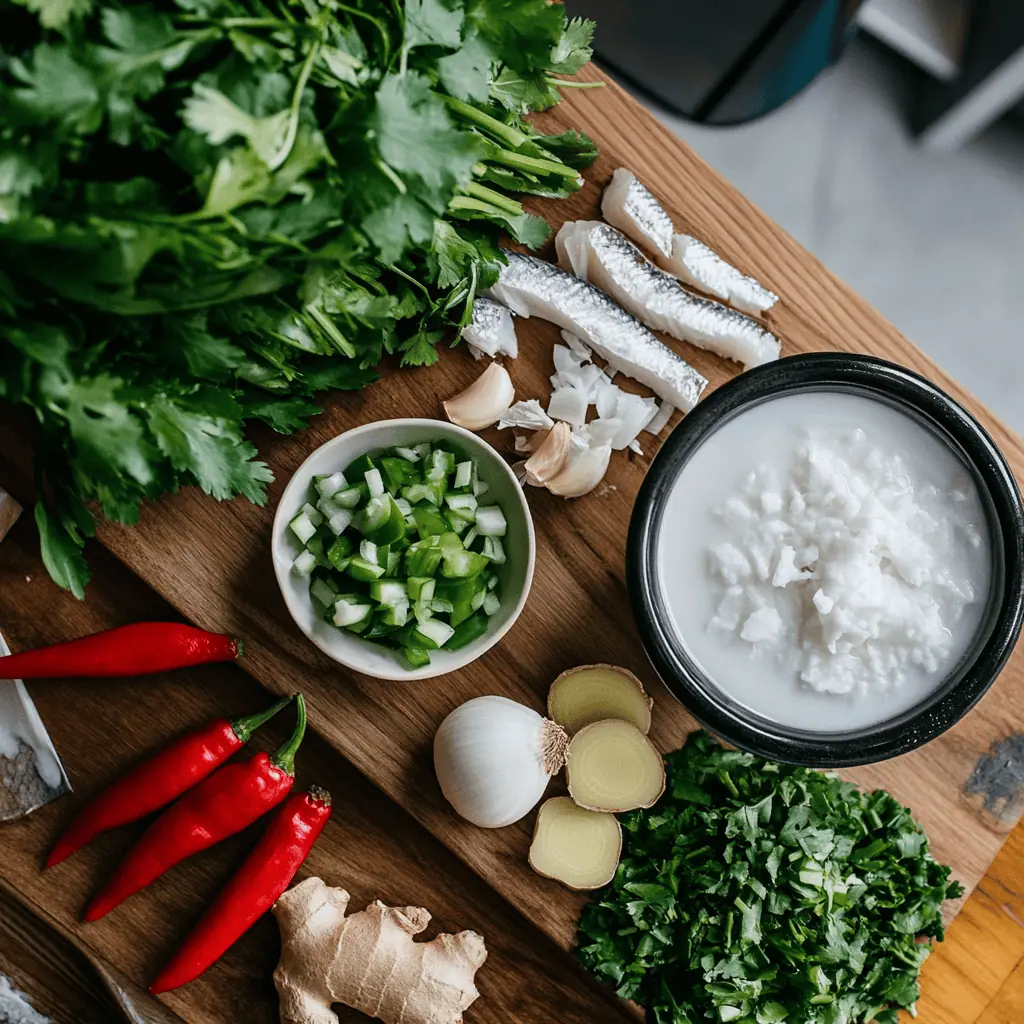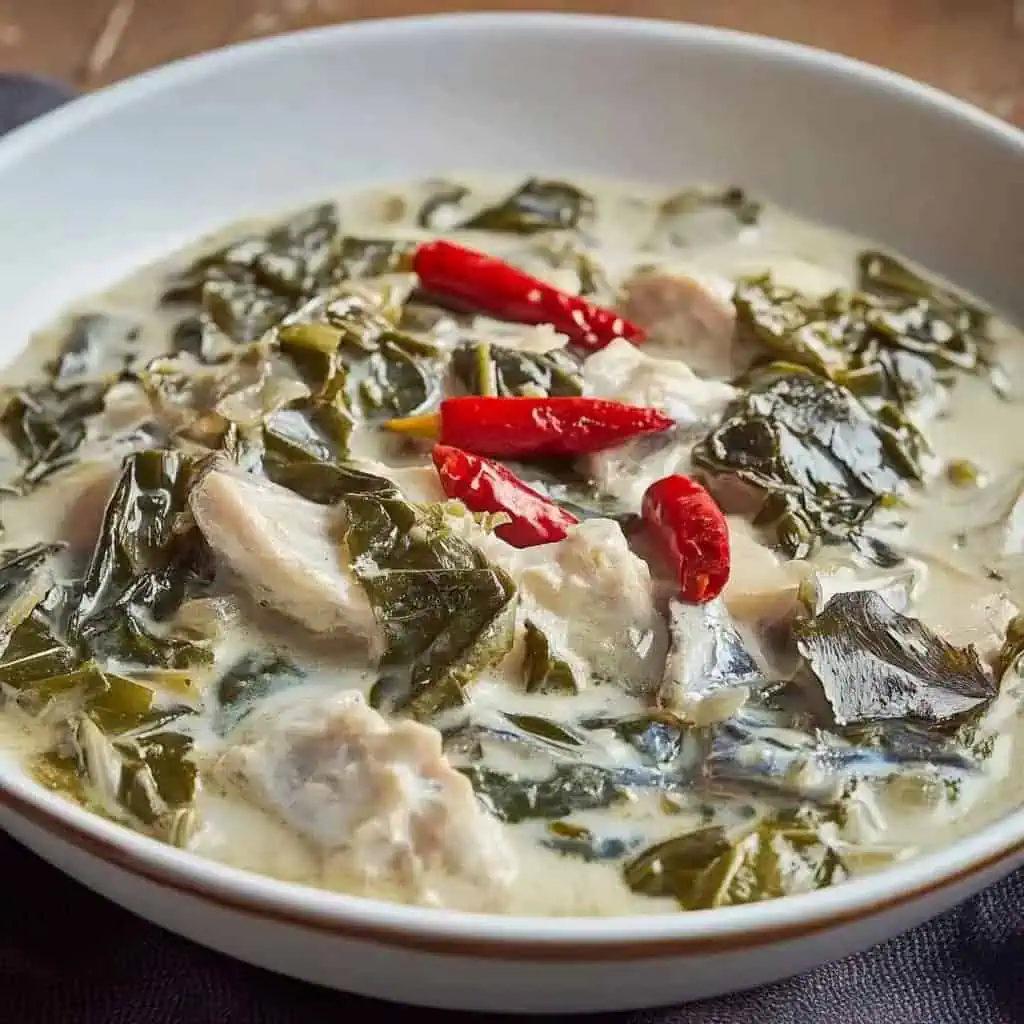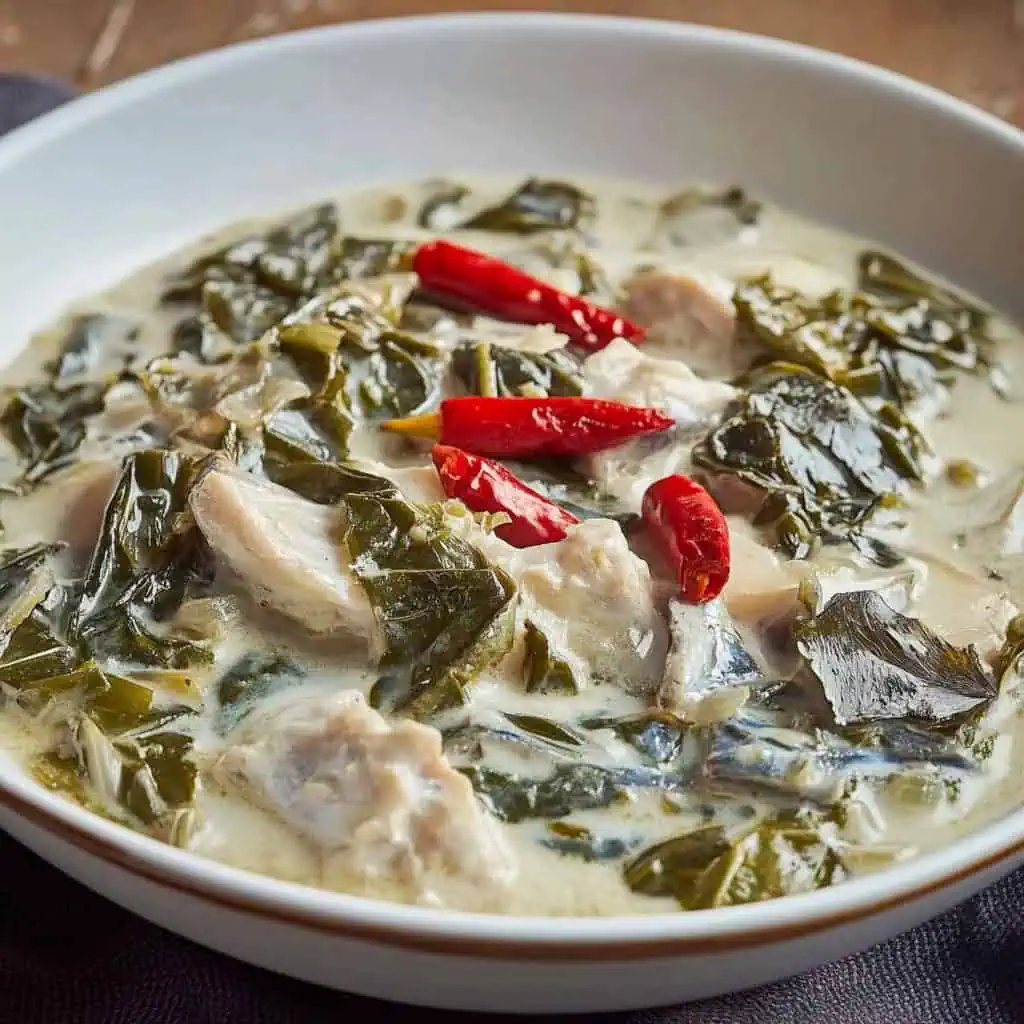Kinunot na Isda was more than just our Sunday lunch, it was my Lola's way of showing love. Every time I make this creamy coconut milk dish with tender tanigue and fresh malunggay leaves, I'm transported back to her tiny kitchen, where she taught me the secret to the perfect gata consistency.
It's amazing how this humble fish recipe brings together everything we Filipinos love: the richness of kakang gata, the gentle heat of siling labuyo, and that comforting aroma that fills the entire house.
Promise, once you master this authentic Bicolano kinunot na isda recipe, it'll become your family's new favorite, too, just like how my own kids now rush to the table whenever they smell the coconut milk simmering with garlic and ginger.
Jump to:

Why You'll Love This Recipe
- Authentic Bicolano flavors passed down through generations
- Perfect balance of creamy coconut and subtle heat
- Nutritious with protein-rich fish and superfood moringa leaves
- One-pot meal that's both comforting and sophisticated
- Keto-friendly and gluten-free
Ingredients
This Kinunot na Isda recipe features carefully selected ingredients that honor traditional Bicolano cooking. Tanigue (Spanish mackerel) provides a firm yet flaky texture that holds up beautifully in coconut milk.
The combination of first-press coconut milk (kakang gata) delivers richness, while the two types of chilies create a balanced heat profile typical of Bicol cuisine. Malunggay leaves add vibrant color, subtle flavor, and impressive nutritional benefits. Fresh ginger and garlic form an aromatic base that counters any fishiness, while vinegar balances the richness with necessary acidity.
Every component works together, creating a dish that's deeply rooted in Filipino coastal heritage yet accessible for home cooks worldwide.

- 500g tanigue (Spanish mackerel)
- 1 medium onion, sliced
- 4 cloves garlic, chopped
- 4 pieces green finger chili (siling pangsigang)
- 2 pieces red bird's eye chili (siling labuyo)
- 1 cup malunggay leaves (moringa)
- ½ cup vinegar
- ¼ teaspoon salt
- ¼ teaspoon black pepper
- ¼ cup water
- 2 cups first-press coconut milk (kakang gata)
- 2-inch piece ginger, sliced
Equipment
- Large pot (kaldero) - For boiling the fish to the perfect tenderness before flaking
- Medium saucepan (kawali) - The ideal vessel for gently simmering coconut milk without curdling
- Wooden spoon (sandok na kahoy) - Essential for the gentle stirring technique that prevents coconut milk from separating
- Strainer (salaan) - Helps drain the fish properly after boiling
- Sharp knife (kutsilyo) - For precise preparation of ingredients
- Cutting board - Provides a clean surface for preparing all ingredients
- Measuring cups and spoons - Ensures recipe accuracy for consistent results

How To Make
- Begin by preparing the fish. Bring water to a boil (100°C/212°F) in a large pot. Add the tanigue and sliced ginger, boiling for 10 minutes or until the fish reaches an internal temperature of 63°C/145°F. Remove fish and let cool completely.
- Once cooled, remove the skin and bones from the fish and flake the meat into bite-sized pieces. Season with vinegar, salt, pepper, and half of the chopped garlic. Let marinate for 5 minutes.
- Heat a medium saucepan over medium heat (175°C/350°F). Add the coconut milk and sliced onions. Stir continuously for 3 minutes until onions soften. It's crucial to stir gently to prevent the coconut milk from curdling.
- Drain the marinated fish and add it to the coconut milk mixture. Simmer until the liquid reduces by 25%, about 10 minutes. Add the moringa leaves, green finger chilies, red bird's eye chilies, and remaining garlic. Cook until the sauce thickens, about 5-7 minutes, or until it reaches 74°C/165°F.
- Serve hot with steaming white rice and calamansi halves on the side. For best results, let the dish rest for 5 minutes before serving to allow flavors to meld together.

Tips from Lola's Kitchen
- Always use the freshest fish possible - Look for clear eyes and bright red gills when selecting your tanigue
- The secret to perfect coconut milk is low heat and patience—never rush the cooking process
- When flaking the fish, take your time to remove all bones thoroughly for the best eating experience
- Add malunggay leaves only in the last few minutes of cooking to preserve their nutritional value and bright color
- Balance the heat level by adjusting chilies to your family's preference, but never eliminate them completely as they're essential to authentic flavor
- Let the dish rest for 5-10 minutes before serving to allow flavors to fully develop
Substitutions
- Fish: If tanigue is unavailable, use fresh tuna, lapu-lapu (grouper), or blue marlin instead
- Malunggay: Fresh spinach or dahon ng sili (chili leaves) can work as alternatives
- Coconut Milk: In a pinch, use premium canned coconut milk, but fresh is always preferred for authentic flavor
- Green Chilies: Banana peppers or jalapeños can substitute for siling pangsigang
- Bird's Eye Chili: For a milder dish, use regular red chilies or even bell peppers for color without heat
- Vinegar: Apple cider vinegar or calamansi juice can replace regular vinegar
Troubleshooting
- Curdled Coconut Milk: Immediately lower heat and stir very gently. Adding a spoonful of room-temperature coconut milk while stirring can sometimes help recover the texture.
- Too Spicy: Add more coconut milk to dilute the heat, or serve with extra rice and a side of cucumber to balance the spiciness.
- Fish Tastes Too Fishy: Marinate fish longer in vinegar (up to 15 minutes) and add more ginger to mask strong flavors.
- Sauce Too Thin: Continue simmering uncovered until it reaches desired consistency, or add a small amount of coconut cream.
- Sauce Too Thick: Gradually add warm water or more coconut milk until reaching ideal consistency.
- Bitter Malunggay: Make sure to add the leaves only in the final 5 minutes of cooking and remove any thick stems.
Storage & Reheating
- Refrigeration: Store in an airtight container in the refrigerator for up to 3 days.
- Best Consumption: For optimal flavor and texture, enjoy within 24 hours of cooking.
- Reheating Method: Warm gently on the stovetop over low heat, adding a splash of coconut milk if needed to revive the sauce.
- Avoid Microwave: Using a microwave can cause the coconut milk to separate—stovetop reheating is always preferable.
- Not Freezer-Friendly: Due to the coconut milk base, freezing is not recommended as it will alter the texture significantly.
- Fresh Garnish: When reheating, add a few fresh malunggay leaves just before serving to brighten the dish.

FAQ
Can I make this dish less spicy for children?
Yes, you can reduce the chilies to just one of each type and remove the seeds. You can also serve chili on the side for adults who prefer more heat.
Why is my coconut milk curdling despite following instructions?
Coconut milk is sensitive to dramatic temperature changes. Make sure your coconut milk is at room temperature before adding it to the pan, and never use high heat.
Can I use frozen fish for this recipe?
Yes, but ensure it's completely thawed and patted dry before cooking. Fresh fish will always give the best results and authentic flavor.
How do I know when the dish is perfectly cooked?
The sauce should coat the back of a spoon but still be pourable. The fish should be tender but still hold its shape, and the malunggay leaves should be bright green.
Is this dish suitable for meal prep?
While you can prepare it a day ahead, it's best enjoyed fresh. If preparing in advance, add the malunggay leaves only when reheating for the brightest flavor and nutrition.
Can I add vegetables to make it a complete meal?
Absolutely! Traditional additions include eggplant, green papaya, or even sweet potato to make it more substantial.
What makes Bicolano cuisine different from other Filipino regional cooking?
Bicolano cuisine is distinguished by its generous use of coconut milk and chili peppers, creating dishes with a signature creamy heat that's unmatched in other regions.
Can I use coconut cream instead of coconut milk?
You can use coconut cream for an extra rich version, but you may need to dilute it slightly with water to achieve the right consistency.
Related
Looking for other recipes like this? Try these:

Kinunot na Isda (Bicolano Fish in Coconut Milk)
Equipment
- Large pot (kaldero) for boiling fish
- Medium saucepan (kawali) for coconut milk mixture
- Wooden spoon (sandok na kahoy) for gentle stirring
- Strainer [Salaan] for draining fish
- Sharp knife (kutsilyo) for preparing ingredients
- Coconut grater (kudkuran) if using fresh coconut
Ingredients
- 500 g tanigue Spanish mackerel / tangigue
- 1 medium onion sliced (sibuyas)
- 4 cloves garlic chopped (bawang)
- 4 pieces green finger chili siling pangsigang
- 2 pieces red bird's eye chili siling labuyo
- 1 cup malunggay leaves moringa
- ½ cup vinegar suka
- ¼ teaspoon salt asin
- ¼ teaspoon black pepper paminta
- ¼ cup water tubig
- 2 cups first-press coconut milk kakang gata
- 2- inch piece ginger sliced (luya)
Instructions
- Begin by preparing the fish (ihanda ang isda). Bring water to a boil (100°C/212°F) in a large pot (kaldero). Add the tanigue and sliced ginger (luya), boiling for 10 minutes or until the fish reaches an internal temperature of 63°C/145°F. Remove fish and let cool completely.
- Once cooled, remove the skin and bones from the fish and flake the meat into bite-sized pieces. Season with vinegar (suka), salt (asin), pepper (paminta), and half of the chopped garlic (bawang). Let marinate for 5 minutes.
- Heat a medium saucepan (kawali) over medium heat (175°C/350°F). Add the coconut milk (kakang gata) and sliced onions (sibuyas). Stir continuously for 3 minutes until onions soften. It's crucial to stir gently to prevent the coconut milk from curdling.
- Drain the marinated fish and add it to the coconut milk mixture. Simmer until the liquid reduces by 25%, about 10 minutes. Add the moringa leaves (malunggay), green finger chilies (siling pangsigang), red bird's eye chilies (siling labuyo), and remaining garlic. Cook until the sauce thickens, about 5-7 minutes, or until it reaches 74°C/165°F.
- Serve hot with steaming white rice (kanin) and calamansi halves on the side. For best results, let the dish rest for 5 minutes before serving to allow flavors to meld together.
Tips from Lola's Kitchen
- Use the freshest tanigue possible - look for clear eyes and bright red gills
- Don't overcook the malunggay leaves to preserve nutrients
- Squeeze coconut milk by hand for the best flavor (pigain ng kamay)
- Control heat by adjusting amount of chilies, not by removing them entirely
- Always stir coconut milk gently to prevent curdling
Nutrition
The Story Behind Kinunot na Isda (Bicolano Fish in Coconut Milk)
Growing up in the coconut-rich region of Bicol, I learned that Kinunot na Isda isn't just another Filipino fish recipe—it's a testament to our ancestors' resourcefulness and culinary wisdom. This traditional Bicolano dish emerged from the bountiful waters of the Bicol region, where fresh Spanish mackerel (tanigue) was plentiful and coconut trees lined every corner of our coastal communities.
The word "kinunot" comes from the Bicolano word "kunot," meaning to flake or shred, referring to how the fish is carefully pulled apart into tender pieces. Originally, our ancestors made this dish with stingray (pagi), but as the recipe traveled through generations, home cooks began using tanigue for its accessibility and delicate flavor. This adaptation shows how Bicolano cuisine evolves while maintaining its soul.
What makes this dish uniquely Bicolano is the signature combination of kakang gata (first-press coconut milk) and siling labuyo (bird's eye chilies)—a pairing that appears in countless dishes from our region. The addition of malunggay leaves wasn't just for flavor; it was our grandmothers' way of sneaking extra nutrition into our meals, long before moringa became known as a superfood worldwide.
Today, Kinunot na Isda remains a beloved dish in Filipino households, especially during family gatherings and fiestas. Its presence on our tables represents more than just a meal—it's a celebration of Bicolano culture, a reminder of our coastal heritage, and proof that the best family recipes are those that tell a story of who we are and where we came from.










Comments
No Comments